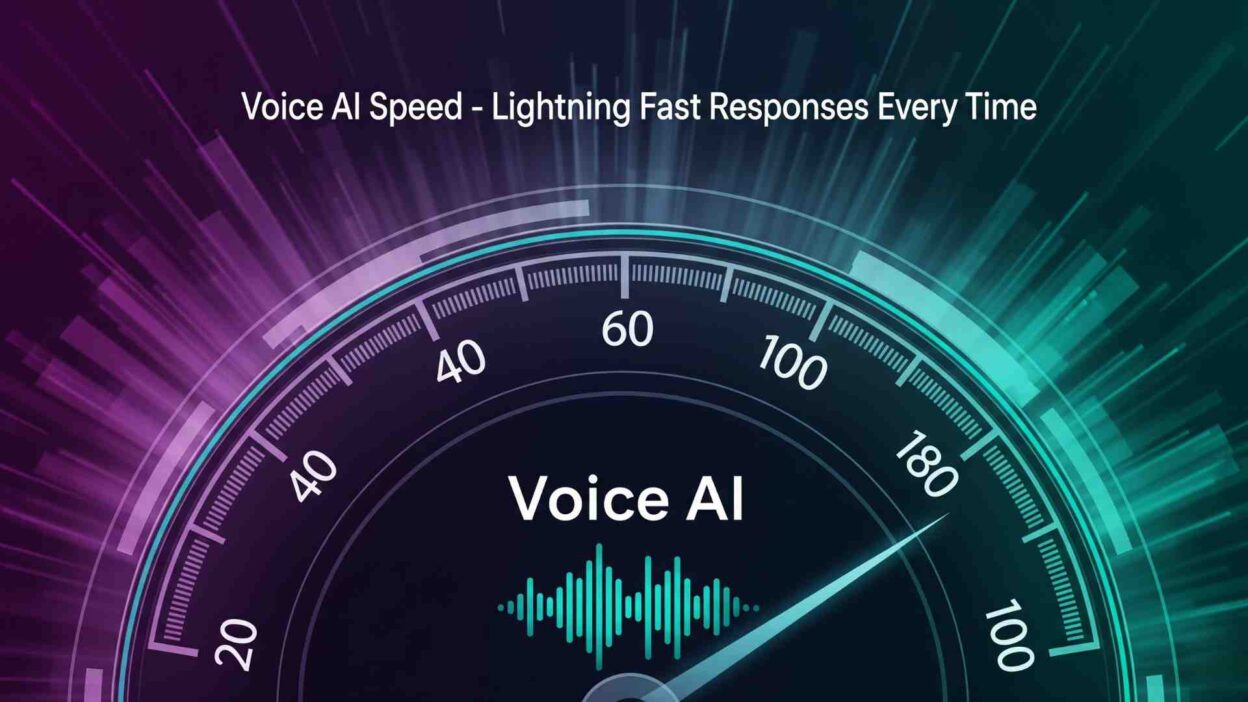TL;DR Voice AI speed revolutionizes how businesses handle customer interactions daily. Modern companies demand instant responses. Customers expect immediate answers. Traditional systems fail to deliver lightning-fast performance.
Table of Contents
Voice AI technology transforms customer service landscapes. Smart businesses adopt these solutions rapidly. Speed determines success in competitive markets.
What Makes Voice AI Speed Critical for Modern Business?
Voice AI speed directly impacts customer satisfaction scores. Slow responses frustrate callers immediately. Fast systems build trust instantly.
Research shows customers abandon calls after 30 seconds of waiting. Lightning-fast voice AI prevents this abandonment. Smart systems respond within milliseconds.
Modern voice AI processes natural language instantly. Advanced algorithms understand context immediately. Machine learning optimizes response times continuously.
Technical Foundations Behind Lightning Fast Voice AI
Real-Time Processing Capabilities
Voice AI speed depends on sophisticated processing architectures. Cloud-based systems deliver consistent performance. Edge computing reduces latency significantly.
Modern systems process audio streams continuously. Speech recognition happens simultaneously with response generation. Lightning-fast algorithms minimize the delay between input and output.
Neural networks optimize for speed and accuracy. GPU acceleration powers complex computations. Parallel processing handles multiple conversations simultaneously.
Advanced Algorithm Optimization
Voice AI speed benefits from continuous algorithmic improvements. Machine learning models train on massive datasets. Performance optimization reduces response latency.
Smart caching systems store common responses. Predictive algorithms anticipate user needs. Lightning-fast retrieval systems access information instantly.
Real-time optimization adjusts to network conditions. Adaptive systems maintain performance during peak loads. Dynamic resource allocation ensures consistent speed.
Measuring Voice AI Speed Performance
Key Performance Metrics
Response time measures voice AI speed accurately. Average handling time indicates system efficiency. Lightning-fast systems complete interactions quickly.
First response time tracks the initial system reaction. Resolution time measures complete interaction duration. These metrics determine overall performance quality.
Uptime percentages indicate system reliability. Concurrent user capacity shows scalability limits. Performance under load tests reveals system stability.
Industry Benchmarks
Leading voice AI systems respond within 200 milliseconds. Lightning-fast solutions achieve sub-100ms response times. Enterprise systems maintain consistency across geographic regions.
Benchmark studies compare different platforms regularly. Speed tests evaluate real-world performance conditions. Industry standards continue evolving rapidly.
Modern systems handle thousands of simultaneous conversations. Scalability tests push systems to maximum capacity. Performance degradation points identify system limits.
Business Impact of Lightning Fast Voice AI
Customer Experience Enhancement
Voice AI speed directly correlates with customer satisfaction. Fast responses create positive interaction experiences. Lightning-fast systems build customer loyalty.
Reduced wait times improve call completion rates. Quick resolutions increase customer happiness scores. Efficient systems handle more inquiries daily.
Customers prefer instant automated assistance over waiting. Voice AI speed eliminates traditional phone queue frustrations. Smart systems route complex queries appropriately.
Operational Efficiency Gains
Lightning-fast voice AI reduces operational costs significantly. Automated systems handle routine inquiries efficiently. Human agents focus on complex problem-solving.
Voice AI speeds increase call center productivity. Faster resolution times allow more customer interactions. Efficient systems reduce staffing requirements.
Cost per interaction decreases with faster systems. Lightning-fast automation scales without proportional cost increases. Smart resource allocation optimizes budget utilization.
Competitive Advantages
Voice AI speed creates significant market differentiation. Fast response times attract customers from competitors. Lightning-fast systems become competitive moats.
Speed advantages compound over time. Efficient systems handle growth without performance degradation. Market leaders leverage technological superiority effectively.
Customer retention improves with faster service delivery. Voice AI speed becomes a brand differentiator. Lightning-fast responses create memorable experiences.
Implementation Strategies for Maximum Speed
Infrastructure Requirements
Voice AI speed requires robust infrastructure foundations. High-performance servers handle processing demands. Lightning-fast networks ensure minimal latency.
Content delivery networks optimize global performance. Edge computing brings processing closer to users. Redundant systems ensure continuous availability.
Bandwidth requirements scale with user volume. Quality of service protocols prioritize voice traffic. Network optimization maintains consistent performance.
Integration Best Practices
Voice AI speed optimization starts with proper integration planning. API design affects overall system performance. Lightning-fast connections require careful architecture.
Database optimization supports rapid information retrieval. Caching strategies reduce repeated processing overhead. Smart routing algorithms optimize resource utilization.
Load balancing distributes traffic efficiently. Monitoring systems track performance continuously. Automated scaling adjusts to demand fluctuations.
Common Speed Bottlenecks and Solutions
Network Latency Issues
Network delays significantly impact voice AI speed. Geographic distance affects response times. Lightning-fast systems require strategic server placement.
Internet connectivity quality varies across regions. Mobile networks introduce additional latency factors. Smart systems adapt to connection quality automatically.
CDN implementation reduces geographic latency. Local processing capabilities minimize network dependencies. Edge computing brings intelligence closer to users.
Processing Overhead
Complex algorithms can slow voice AI speed. Inefficient code creates unnecessary delays. Lightning-fast systems require optimized implementations.
Memory management affects processing speed. Garbage collection pauses interrupt real-time performance. Smart allocation strategies minimize overhead.
Database queries introduce processing delays. Optimized schemas support faster information retrieval. Indexing strategies improve query performance significantly.
Future of Voice AI Speed Technology
Emerging Technologies
5G networks will revolutionize voice AI speed capabilities. Ultra-low latency connections enable new applications. Lightning-fast mobile interactions become possible.
Quantum computing promises unprecedented processing speeds. Advanced neural networks optimize automatically. Edge AI brings intelligence directly to devices.
Federated learning improves models without centralized processing. Distributed systems scale infinitely. Smart optimization happens automatically.
Industry Predictions
Voice AI speed will continue improving exponentially. Lightning-fast responses become standard expectations. Real-time processing becomes ubiquitous.
Integration with IoT devices expands voice AI applications. Smart homes respond instantly to voice commands. Automotive systems provide immediate assistance.
Enterprise adoption accelerates across industries. Voice AI speed becomes a competitive necessity. Lightning-fast automation replaces traditional interfaces.
Best Practices for Optimizing Voice AI Speed
Performance Monitoring
Continuous monitoring tracks voice AI speed metrics accurately. Real-time dashboards display performance indicators. Lightning-fast alerting systems notify of issues immediately.
Automated testing validates performance regularly. Load testing identifies capacity limits. Performance regression testing prevents speed degradation.
User feedback provides qualitative speed assessments. Analytics platforms track interaction patterns. Smart optimization algorithms improve performance continuously.
System Maintenance
Regular updates maintain voice AI speed optimization. Security patches must not compromise performance. Lightning-fast deployment processes minimize downtime.
Database maintenance prevents performance degradation. Index optimization supports faster queries. Cache clearing removes stale data effectively.
Hardware refresh cycles maintain processing capabilities. Cloud scaling adjusts to demand automatically. Smart resource allocation optimizes costs continuously.
Selecting the Right Voice AI Speed Solution
Evaluation Criteria
Voice AI speed should be the primary selection criterion. Response time benchmarks guide technology choices. Lightning-fast performance requirements must be clearly defined.
Scalability requirements affect platform selection. Peak load handling capabilities determine suitability. Smart growth planning prevents future bottlenecks.
Integration complexity impacts implementation timelines. API quality affects overall system performance. Support quality ensures rapid issue resolution.
Vendor Comparison Framework
Speed benchmarks compare platforms objectively. Real-world testing validates vendor claims. Lightning-fast performance must be demonstrated consistently.
Cost analysis includes performance value assessment. Hidden latency costs affect total ownership. Smart procurement considers long-term implications.
Support quality directly impacts system performance. Technical expertise ensures optimization success. Partnership approach drives continuous improvement.
Cost-Benefit Analysis of High-Speed Voice AI
Investment Requirements
Voice AI speed optimization requires significant infrastructure investment. High-performance hardware increases initial costs. Lightning-fast systems demand premium components.
Network optimization adds operational expenses. Bandwidth requirements scale with performance needs. Smart planning balances cost and performance effectively.
Maintenance costs increase with system complexity. Specialized expertise commands premium rates. Performance monitoring tools require additional licensing.
Return on Investment
Lightning-fast voice AI delivers measurable business benefits. Customer satisfaction improvements drive revenue growth. Operational efficiency gains reduce ongoing costs.
Competitive advantages create market share gains. Voice AI speed differentiation attracts premium customers. Smart positioning leverages technological superiority.
Long-term benefits compound significantly. Initial investments pay dividends continuously. Performance advantages create sustainable competitive moats.
Security Considerations for High-Speed Voice AI
Real-Time Security Challenges
Voice AI speed optimization must not compromise security. Lightning-fast systems require robust protection mechanisms. Real-time threat detection prevents malicious attacks.
Encryption overhead affects processing speed. Security protocols must balance protection and performance. Smart implementation minimizes latency impact.
Authentication systems must operate efficiently. Voice biometrics enable secure, rapid access. Lightning-fast identity verification enhances user experience.
Compliance Requirements
Regulatory compliance affects voice AI speed implementations. Data protection laws require specific safeguards. Lightning-fast systems must maintain audit trails.
Industry standards mandate security measures. Healthcare applications require HIPAA compliance. Financial services demand additional protections.
Smart compliance strategies minimize performance impact. Automated systems ensure regulatory adherence. Performance optimization respects security boundaries.
Troubleshooting Voice AI Speed Issues
Common Performance Problems
Network congestion affects voice AI speed directly. Bandwidth limitations create bottlenecks. Lightning-fast systems require adequate connectivity.
Server overload causes response delays. Resource contention slows processing. Smart load balancing prevents performance degradation.
Database inefficiencies impact query speed. Unoptimized schemas create delays. Index maintenance ensures fast information retrieval.
Diagnostic Approaches
Performance monitoring identifies speed bottlenecks accurately. Real-time analytics track system behavior. Lightning-fast troubleshooting prevents extended outages.
Network analysis reveals connectivity issues. Packet loss measurements indicate problems. Smart diagnostics pinpoint root causes quickly.
Load testing validates performance under stress. Capacity planning prevents future bottlenecks. Optimization strategies improve overall speed.
Read More: Voice AI Scalability: From 10 to 10,000 Calls Instantly
Conclusion

Voice AI speed transforms customer service delivery fundamentally. Lightning-fast responses create exceptional user experiences. Modern businesses require instant interaction capabilities.
Speed optimization delivers measurable competitive advantages. Customer satisfaction improves dramatically with faster systems. Operational efficiency gains justify technology investments.
Smart implementation strategies maximize voice AI speed benefits. Proper infrastructure supports lightning-fast performance. Continuous optimization maintains competitive positioning.
Future voice AI systems will be even faster. Technology advancement continues to accelerate. Lightning-fast responses will become standard expectations.
Organizations must prioritize voice AI speed in technology selections. Performance requirements should guide platform decisions. Smart investments in speed optimization pay long-term dividends.
Voice AI speed represents the future of customer interaction. Lightning-fast systems define market leadership. Success depends on embracing these technological capabilities immediately.





